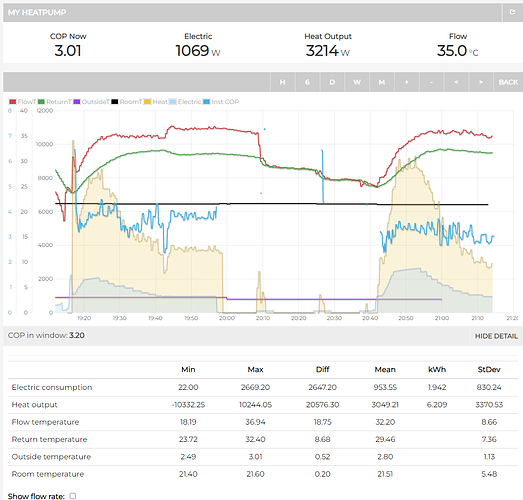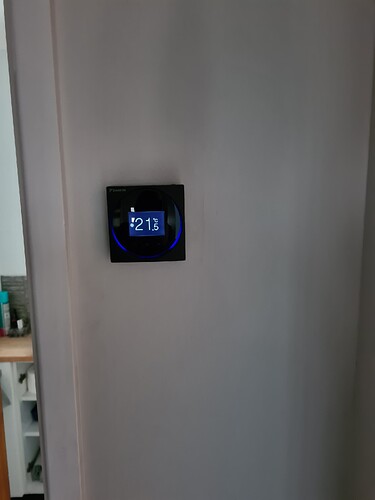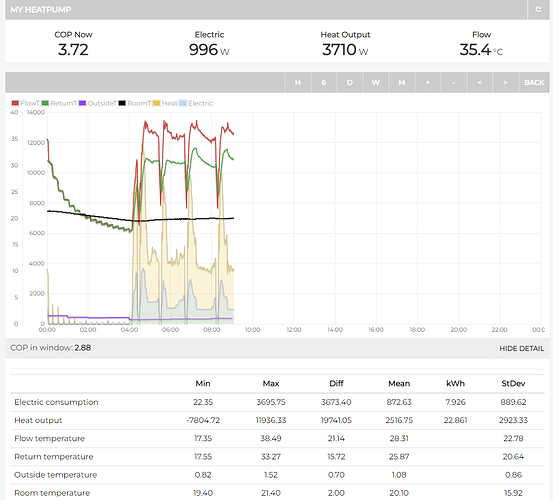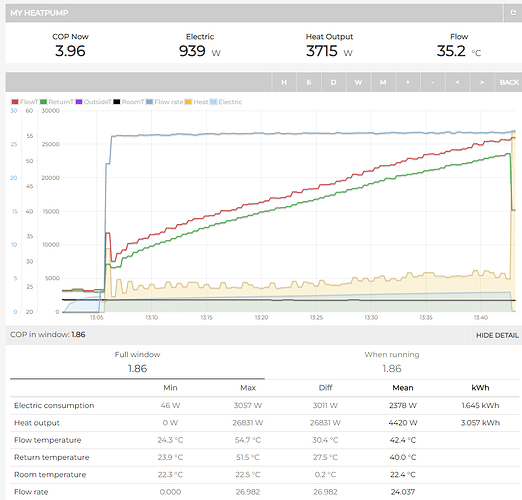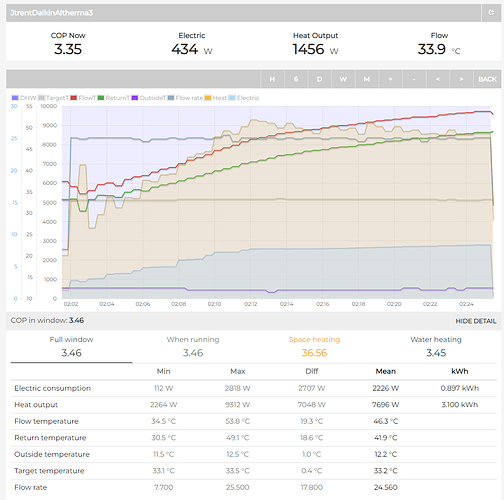Though this includes the morning when the boost heater was running - it’s been averaging 3.0 since then. Not great but less bad.
Yes it does Tim, sorry, my mistake, I was looking at the instant COP and then wrote down the COP for the day thinking I had only selected the current heating cycle.
Yes, it is less bad, but not really what you would hope for in a house that can heat to 22c with 32.5c water flowing through the radiators at 4c outside.
It should be outstanding?
Well it is of course, but outstanding for the wrong reason!
So, not as bad as usual, as I predicted, but still worse than leaving it running.
Im a bit confused now, so much information over the last two weeks, maybe it is a characteristic of my house, the heat pump or a combination of both but the start up is poor and so my inclination to just let it run is correct.
Well, in terms of COP anyway. Whether that is the best or most efficient way to heat our house I don’t know, I would have to do some work on that but it seems a bit pointless when major changes are imminent.
All I know is the poor COP depresses me and reminds me that I have the wrong heat pump, not that I really need reminding!
I don’t think it makes a lot of difference what I do, the heat required is fixed and nothing has much of an effect on the COP, it’s 3.5 plus or minus a little.
And that makes sense really as it is generally providing about 50% more heat than we need when running efficiently or using 50% more electricity than it should when providing the heat the house actually needs. Which one of those it is determined by the flow temperature, higher flow temperature = too much heat, lower flow temperature = correct heat but poor COP due to minimum electricity input.
Just to note: not just colder, but the dew point is also now moving frustratingly into the region where ice builds up (becoming the “frost point”) on the fins of the outdoor unit, which then starts acting as a (very good) insulator, and then eventually also blocks airflow……
This effect (even prior to the actual defrost which is easily spotted in the data), will drag efficiency down.
The effect is most pronounced directly prior to the defrost in the visual data, where input electrical power ramps up to drive the fan(s) and compressor harder and faster to compensate for the reduction in heat exchange and air flow rate through the back/side of the unit.
Eventually it (should) give up and say to itself (algorithmically and via ice build up sensor(s)): “I’m better defrosting (taking heat from inside the house to melt the ice formation) than carrying on at the reduced CoP.
Some (our Daikins for example as I see it it milder weather too) have algorithms that are somewhat dumb, and for example defrost when it’s warm outside and no physical frost formation.
Vinny mentions this here:
And Alison Bailes (USA) discus this issue here:
So just note this point when analysing your data feeds as we are now moving into a very different season with different observable characteristics on heat pump running.
I think it is running pretty well this morning, much better without the BUH!
We are close to the system design conditions now, it is 0c outside now
Heat requirement to maintain this is a bit less than 4kW and I am still sitting in the conservatory that should be cold but isn’t, it’s warm as it usually is, about 20c now.
I think the evidence is conclusive, the heat loss of my house including the conservatory is a little over 4kW at the design temperatures, probably no more than 4.5kW
What can I have gone wrong with my heat loss survey?
The house was drawn correctly and the construction and fabric of the house seems to be accurately represented from what I have seen.
But it is not what I am experiencing and it is not what my historical and present heating data shows.
Is there any way I can convince my installer that the heat loss is nowhere even close to what the have calculated?
I think I have found the problem with the heat loss calculation.
Downstairs my house is 22c, upstairs is 20c and the conservatory is 19c, everything is working well and so far today I have put 38kWh of heat into the house in 13 hours, so the heat loss is about 3kW with an average outside temperature of 1.5c
The temperature of the house dropped a little between 00.00 and 04.00 as I set the temperature back from 22c to 20c between 00.00 and 04.00.
If I ignore those four hours and say I have put in 38kWh over 9 hours then the heat loss is 4.2kW so the real figure at 1.5c outside is somewhere between 3kW and 4.2kW as the house has warmed up a little since 04.00 so lets say it is 4kW.
It’ll probably need another 500w if it was -2.3c outside so my real heat loss at the design temperature is about 4.5kW
Octopus have calculated it at 7.4kW
2.3kW of that is attributed to our conservatory but it was originally surveyed at 827w
So I have done a rough calculation based on some crude measurements and not to over complicate it.
The conservatory is attached to the back of the house with double glazed doors into the dining room.
The conservatory gains some heat from the dining room as that is designed to be at 21c whilst the conservatory is only designed at 16c but I’ll ignore it and assume there is only heat loss from the three external sides of the conservatory and the roof.
The conservatory has a brick cavity insulated wall at 600mm on one side.
The wall is 3.80m long and has a heat loss of (3.80 x 0.60 x 0.18 x 18.23) 75w
The conservatory is 3.80m x 3.40m with 2.10m high glass walls. That gives a glazed area of 19.02m2 when I take out the brick part.
The roof is 19.00m2.
The floor area is 12.92m2
The glazed walls are 28mm Pilkington Planitherm Super Space Bar Low Emission Argon filled Low Iron double glazed units.
The roof is glazed with Pilkington 24mm Blue Activ 24mm solar control double glazed units.
The u value of these units is between 1.2 and 1.5 w/m2K
I will use a u value of 1.5 w/m2K
At a delta t of 18.3c (16c inside and -2.3c outside) I calculate the heat loss of the glazed part as (38.02 x 1.5 x 18.3) 1,044w and then add the brick wall and the total is 1,119w
I will assume that the gain from the dining room compensates for the loss from air changes.
This heat loss seems more realistic and would explain why the conservatory is not cold. If I use a u value of 1.2 for the glass then the heat loss is only 910w plus heat lost from air changes and minus heat gained from the adjoining room. It’s how I am able to heat it with this radiator at 35c flow with no trouble.
Have I made any glaring errors?
Something is wrong with my data feeds.
I had to turn the BUH on earlier as I had been changing radiators and wanted to make sure the heat pump could defrost.
Now I am showing a constant 3,350w electricity consumption even though the heat pump is turned off at the mcb.
That backup heater input was stuck on it’s last value and that’s the value that was then being added to the total sum. I’ve fixed it as best as I can, not perfect but at least more correct than before.
Thank you.
Hi Matt,
Thanks first for posting all the info in this thread it’s been nice to know that I am not going mad. In some ways it’s nice to know I’m not alone, I am also an Octopus customer with a 9kW Daikin heat pump.
I have also been experiencing poor COP from my heat pump due to I suspect it being over-sized(Over the year according to the MMI data I have seen 2.48 for heating and 1.8 for hot water).
I have been communicating with their support team and have found their response to be somewhat akin to gas lighting trying to convince me that there is nothing wrong with their install and it’s all down to the inaccuracy in the MMI.
They keep trying to tell me the system is not over-sized and the amount of cycling I’m seeing is normal and not a problem.
I see you also have 3rd party monitor tools do they roughly agree with the MMI readings on the heat pump or are they very different?
The most disappointing thing is that in all other areas Octopus have been a great company.
I knew this was a new venture for them and I did expect some risk of issues but with how good their customer service normally is I expected so much more.
When I got their quote and estimate it stated I need a 9kW heat pump and a load of new radiators some in rooms that had a tendency to be too hot with my then Condensing boiler.
I suspect some of the rooms they have put radiators that are too large while others have some that are too small and they never replaced. I have problems with some of the north facing rooms not getting as warm as the rest of the house.
I explained that I already had a weather compensating boiler that was running with a flow temp rarely above 40 degrees in the high 20’s to low 30’s most of the year.
My boiler also provided stats for gas use and I even warned them their calcs were at least 20% above what my boiler was using.
I later actually looked at my gas bill and saw I was using about 9’000kWh of gas in a year(heating, water, & cooking) their performance estimate stated I need 10’000kWh just for heating for the year. The MMI says the heat pump has provided ~6’000kWh for heating in the last 12 months.
I suspect like with you they messed up the survey in hind sight at that point I should have just walked but it was hard finding anyone to install a heat pump in my area at the time…
I will have to do whats needed to put it right as otherwise it will just bug me.
Hi Robert,
Thanks for posting.
You are not mad, I think this is a tricky heat pump to deal with. I say this because of its limited range of operation and what feels like an eternity to settle down into a steady state of operation. It may just be me and my house but I am still convinced there is something wrong with it, great at times and difficult to understand at others.
My main issue at the moment is DHW production is inconsistent and I suffer a decaying flow temperature regularly, particularly when resuming heating after a DHW cycle. Maybe @marko has an idea? I don’t know why but my gut feeling is a lack of refrigerant or some problem in that area. At times I cannot get the flow temperature to increase at all, it just reduces even though I am using a fixed flow temperature and requesting an increase.
Concentrating on COP alone, at the lower heat outputs we are limited by the minimum electrical heat input of around 900w, that means at a COP of 5, which I get sometimes, the heat output is 4,500w, a lot for a house my size and with my heat loss.
If you can get the heat pump to operate like this then you just have to accept the heat.
Running for shorter periods is OK and stops the house heating up too much but you are always operating in the most inefficient phase of the heating cycle, COP will always be lower than it could ideally be.
Thinking of radiator sizes, to run at 35c flow with a delta t of 10c between mean flow temperature of around 32c and room of 22c you need about 38kW (at dT 50c) of radiators to accommodate the heat output. I had about 18kW of radiators after the install. My house was warm enough at 35c flow or below but the COP was bad.
I needed to run at around 42c flow to get a COP of around 3.5, but then the heat output is higher and my house got hotter which then diminishes the heat output of the radiators.
Once the heat pump can no longer get rid of the heat produced it has to cycle.
I guess that is what you are experiencing.
How big is your house and how big are the radiators?
You may think they are big enough because they worked with your gas boiler, and they will work just like my old ones but the COP will be poor.
I had my trvs wide open on my old radiators but with my new radiators I have no trvs, you cannot afford any to stop working if you aim for the best efficiency.
Again with this heat pump, because the minimum heat output at a decent COP is so high it is highly likely there is no house on the planet where this heat pump fits, basically you need a house with a heat loss that varies between 4.5kW and 6.3kW at the extremes of the heating temperature window if you want to be able to run for extended periods and get a decent COP, compromises are necessary a lot of the time, they are with most heat pumps but this one is the worst I can see.
That does mean that you ideally need to size the radiators to the heat loss of the room or accept uncomfortable room temperatures if you get it wrong.
Do you have your radiator schedule? It would be helpful to see it.
I don’t look at the MMI data very often, but when I have, it does broadly match my heat meter data.
You can view my heat pump data and performance here HeatpumpMonitor.org
I am in Ipswich
Your previous gas usage is relevant but the annual consumption only applies if you kept the house at the same temperature at all times, they can’t design a heat pump to work at keep your house warm at certain points of the day, they have to base the size on the heat loss at certain design temperatures.
What did they come up with for your house?
I felt my heat loss was 5kW or less at 21c/-2.3c but Octopus say 7.4kW
My problem is a heated conservatory, it doesn’t lose as much heat as they say because the construction is different to what they used, it has argon filled glass and loses less than half the heat they say.
Having experienced a few cold days and one in particular when I had the heating off all day, due to the frequent defrosting the heat pump didn’t feel particularly too big, it wasn’t struggling but it was clearly closer to the limit than I expected.
Octopus are willing to fit me the smaller 8kW heat pump but I have declined the offer, I would rather accept the lower COP and/or excess heat than struggle to heat the house with the smaller heat pump.
I feel the 8kW would be marginal here when defrosting at maximum frequency although it would be much better most of the time.
I was told by Octopus that they do cheap installs and don’t offer efficient installations.
I have no problem with that, like you, they did a good job of actually fitting the heat pump and I am grateful to them for doing it as I could find nobody else.
However, I never imposed any financial constraints on the installation and I think they should have either made it clearer what they were offering or offered to do the job properly. Or even maybe tell me what needed doing.
Not at any stage was I told that I wouldn’t be able to run at low flow temperatures, no indication that it would be a problem if I did, and at no point did any of the installer say that they thought the heat pump was a bit big for the house, they are fitting these in houses 50% or more larger than mine, they would normally fit a 7kW in a house this size (now an 8kW)
Messing up heat loss surveys is normal, they overestimate air changes, and they will always err on the side of bigger when it comes to the heat pump, it’s a safe bet that you won’t be cold.
None of this would be bad unless you fall on the cusp between 8 and 9kW.
They are completely different classes of heat pump, the 9 sounds just a little bigger but it’s not, it’s twice the size of the 8 because it’s really a 16kW heat pump.
All Daikin have done is design one heat pump and limit the maximum heat output to give a range of four heat pumps.
All of them are almost identical in every way including the minimum electrical input. The 16kW consumes 900w at the low end just like our 9kW heat pumps. Great if you have a 350m2 house as you have both ends of the scale covered, not so great if your house is only 100m2, what I am supposed to do with the heat output of a 16kW heat pump in a house like mine?
So, tell more about your house and how you are running the heat pump and I am sure me and the others here will be able to improve your situation.
I am aware of one other 9kW owner installed by Octopus who is in the process of getting it changed for the 8kWas they messed up his heat loss calculation and he suffers the same issues as you and I.
Hi Rob,
I would be another owner of the “Amazing” EDLA09DA3V3… (Farnborough, Hampshire)
So Octopus originally worked out my heat loss to 7.3kw so I got the 9kw unit. From the start it was a bit like taming a volcano but I was told “this is normal, cycling is expected this time of year” then it got to November and below 10°c.
Personally I carried out a heat loss survey of my own using heat punk and got in a heat geek (at my expense post Octopus install) to give me not only a good solid idea of my actual heat loss around 5.5kw but also to allow me to have a better idea of the radiators I would need for a 40°c flow temp. I also created a scatter graph showing heat output of the heatpump (from the mid certified heat meter) Vs the outside temperature and this shows at -4°c I would need 5kw to heat the house.
I then reached out to the senior installer from our job with this information and explained all my findings and the figures and that I was not happy.
Due to my specific installation being more custom (with full solar PV integration via Octopus) the Operations Director had already been round to review and check the install and called me back the same day.
It has been a week for them to verify my heat loss figures provided and to confirm that the replacement radiators (yes the heat loss was that wrong we need to swap out some of the new radiators to make the system work) recommended by me and the heat geek installer would be ok but we are now in the queue for a swap out mid January.
As the EDLA 4,6&8 are the same unit just derated (with a ~400w minimum power for compressor and pump) I am reasonably confident that it will give us much better performance and just like going for the EDLA09 gives minimal low end benefits Vs the EDLA16.
Re the MMI data it is good for an indication but it does not use certified meters and it should be viewed as a guestimate at best.
You can pull the values using some third party projects such as P1P2Serial or ESPAltherma (both feed directly into home assistant) to give you a clearer picture but in all honesty without the open energy monitor emonhp I would never have seen how poor my performance was or been able to identify the continual cycling as easily.
It also helps you can now name (and shame) your installer on the heatpumpmonitor.org portal for all to see.
If you want to chat about a way forward I am happy to help share how I got things sorted but I did spend out and take some time to ensure that all my facts and figures where spot on before tackling them. If you just rock up saying it is expensive and you think it is oversized they may just brush you off as ‘they know what they are doing’ which it sounds like they have been.
I have the EDLA 4/6/8 and can confirm it trucks along with the compressor on 24/7 pulling 4-450w at the minimum flow rate. It’s neat.
https://emoncms.org/app/view?name=JtrentDaikinAltherma3&readkey=9ce13d5a95943eb1e95f03e12efe2a89
I have some inefficiencies in my system but that’s mainly because we’re living in a property we are in the process of renovating - I only have about 2/3 of my heating system in. It makes it hard to get the delta T above 4 (wants to be at 5 for my system) so affects the COP. House is lovely and warm though. In mild weather (11c or so) It’s getting 4.5-4.8. Tonight it’s definitely acting up, its running constantly as I’d like it to but struggling to shed enough heat.
Interesting you say the three units are the same mechanically - I had heard that as a rumour but wasn’t sure it was true.
Are you sure you don’t want to do the swap @matt-drummer? Feels like you would have jumped at the offer previously.
I have also been experiencing poor COP from my heat pump due to I suspect it being over-sized(Over the year according to the MMI data I have seen 2.48 for heating and 1.8 for hot water).
This part concerns me, as it does for my heat pump.
Oversizing should have no bearing on DHW production.
Your figure seems low, as does mine.
Does it indicate another issue?
Two thoughts on this;
-
how good (size, length of run and how well insulated) are the primaries from the heat pump to the Esbe?
-
What value do you have set for “Installer Settings → Balancing → Maximum running timer” Ours was set to 30 and we regularly had a DHW COP of 1.x, Changed this to 90 minutes (rarely takes over 45) and we are seeing in the region of 2.3 for DHW
That is some very low and slow heating action, good work. What’s your design flow temperature and how are you finding it?
Hi Jordan,
Initially I was so shocked at how bad the heat pump was in my house and despite really knowing about the radiators being too small my disappointment got the better of my rational thinking.
Whilst my original radiators would have worked with the 8kW on warmer days, when it was cold I would have had to run the smaller heat pump at higher flow temperatures.
I think if Octopus had been more amiable about discussing the problem rather than just trying to tell me it was normal, run it for shorter periods and that they don’t install efficient systems then I may have bitten their hands off when offered the swap.
But it has been a while, I have developed a strategy to deal with this heat pump and I have already replaced my radiators.
I have no faith in Daikin and I am convinced that Octopus don’t understand the limitations of these heat pumps they are installing.
I have also experienced severe defrosting.
There is no way my heat pump would have got to my 50c design flow temperature, it could barely get to 40c when asked before defrosting. It would never do it without the BUH, not that I ever want to use it.
I have serious doubts about whether the 8kW could heat my house at 0c when defrosting every 20 minutes and it does not come equipped with a BUH in the UK.
So for me, it’s a case of `better the devil you know’
At least I know this one works and if I swapped and had trouble I would have nowhere to go, Octopus would disown me in that respect.
I’m curious, in what way do you mean your heat pump is struggling to shed enough heat?
Two thoughts on this;
how good (size, length of run and how well insulated) are the primaries from the heat pump to the Esbe?
What value do you have set for “Installer Settings → Balancing → Maximum running timer” Ours was set to 30 and we regularly had a DHW COP of 1.x, Changed this to 90 minutes (rarely takes over 45) and we are seeing in the region of 2.3 for DHW
Jordan’s DHW is very different to mine.
The COP is miles better but so is the heat output, it’s not what you would expect to see from a 9kW heat pump My run took 45 minutes and my maximum heat output at the end is 6.3kW, it’s even less early in the run. And my flow rate is higher.
Mine
And this is Jordan’s, quite a difference,
40c at -2, it’s 16mm underfloor heating in a biscuit screed on top of 100mm pir in suspended wooden floor. Like with many heat pumps you figure out that they run more efficiently at a minimum temp so my curve is very low pitch, I think it’s 32 at 14c and 40 at -2 last i tinkered with it.
It may al change once I have all my heating in but will see!
